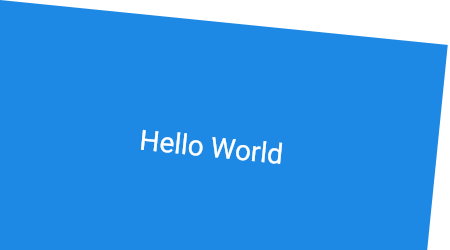Container class
A convenience widget that combines common painting, positioning, and sizing widgets.
A container first surrounds the child with padding (inflated by any
borders present in the decoration) and then applies additional
constraints to the padded extent (incorporating the width and height
as constraints, if either is non-null). The container is then surrounded by
additional empty space described from the margin.
During painting, the container first applies the given transform, then paints the decoration to fill the padded extent, then it paints the child, and finally paints the foregroundDecoration, also filling the padded extent.
Containers with no children try to be as big as possible unless the incoming
constraints are unbounded, in which case they try to be as small as
possible. Containers with children size themselves to their children. The
width, height, and constraints arguments to the constructor override
this.
By default, containers return false for all hit tests. If the color property is specified, the hit testing is handled by ColoredBox, which always returns true. If the decoration or foregroundDecoration properties are specified, hit testing is handled by Decoration.hitTest.
Layout behavior
See BoxConstraints for an introduction to box layout models.
Since Container combines a number of other widgets each with their own layout behavior, Container's layout behavior is somewhat complicated.
Summary: Container tries, in order: to honor alignment, to size itself
to the child, to honor the width, height, and constraints, to expand
to fit the parent, to be as small as possible.
More specifically:
If the widget has no child, no height, no width, no constraints,
and the parent provides unbounded constraints, then Container tries to
size as small as possible.
If the widget has no child and no alignment, but a height, width, or
constraints are provided, then the Container tries to be as small as
possible given the combination of those constraints and the parent's
constraints.
If the widget has no child, no height, no width, no constraints, and
no alignment, but the parent provides bounded constraints, then
Container expands to fit the constraints provided by the parent.
If the widget has an alignment, and the parent provides unbounded constraints, then the Container tries to size itself around the child.
If the widget has an alignment, and the parent provides bounded constraints, then the Container tries to expand to fit the parent, and then positions the child within itself as per the alignment.
Otherwise, the widget has a child but no height, no width, no
constraints, and no alignment, and the Container passes the
constraints from the parent to the child and sizes itself to match the
child.
The margin and padding properties also affect the layout, as described in the documentation for those properties. (Their effects merely augment the rules described above.) The decoration can implicitly increase the padding (e.g. borders in a BoxDecoration contribute to the padding); see Decoration.padding.
Example

Center(
child: Container(
margin: const EdgeInsets.all(10.0),
color: Colors.amber[600],
width: 48.0,
height: 48.0,
),
)
Container(
constraints: BoxConstraints.expand(
height: Theme.of(context).textTheme.headlineMedium!.fontSize! * 1.1 + 200.0,
),
padding: const EdgeInsets.all(8.0),
color: Colors.blue[600],
alignment: Alignment.center,
transform: Matrix4.rotationZ(0.1),
child: Text('Hello World',
style: Theme.of(context)
.textTheme
.headlineMedium!
.copyWith(color: Colors.white)),
)See also:
- AnimatedContainer, a variant that smoothly animates the properties when they change.
- Border, which has a sample which uses Container heavily.
- Ink, which paints a Decoration on a Material, allowing InkResponse and InkWell splashes to paint over them.
- Cookbook: Animate the properties of a container
- The catalog of layout widgets.
- Inheritance
-
- Object
- DiagnosticableTree
- Widget
- StatelessWidget
- Container
Constructors
- Container({Key? key, AlignmentGeometry? alignment, EdgeInsetsGeometry? padding, Color? color, Decoration? decoration, Decoration? foregroundDecoration, double? width, double? height, BoxConstraints? constraints, EdgeInsetsGeometry? margin, Matrix4? transform, AlignmentGeometry? transformAlignment, Widget? child, Clip clipBehavior = Clip.none})
- Creates a widget that combines common painting, positioning, and sizing widgets.
Properties
- alignment → AlignmentGeometry?
-
Align the child within the container.
final
- child → Widget?
-
The child contained by the container.
final
- clipBehavior → Clip
-
The clip behavior when Container.decoration is not null.
final
- color → Color?
-
The color to paint behind the child.
final
- constraints → BoxConstraints?
-
Additional constraints to apply to the child.
final
- decoration → Decoration?
-
The decoration to paint behind the child.
final
- foregroundDecoration → Decoration?
-
The decoration to paint in front of the child.
final
- hashCode → int
-
The hash code for this object.
no setterinherited
- key → Key?
-
Controls how one widget replaces another widget in the tree.
finalinherited
- margin → EdgeInsetsGeometry?
-
Empty space to surround the decoration and child.
final
- padding → EdgeInsetsGeometry?
-
Empty space to inscribe inside the decoration. The child, if any, is
placed inside this padding.
final
- runtimeType → Type
-
A representation of the runtime type of the object.
no setterinherited
- transform → Matrix4?
-
The transformation matrix to apply before painting the container.
final
- transformAlignment → AlignmentGeometry?
-
The alignment of the origin, relative to the size of the container, if transform is specified.
final
Methods
-
build(
BuildContext context) → Widget -
Describes the part of the user interface represented by this widget.
override
-
createElement(
) → StatelessElement -
Creates a StatelessElement to manage this widget's location in the tree.
inherited
-
debugDescribeChildren(
) → List< DiagnosticsNode> -
Returns a list of DiagnosticsNode objects describing this node's
children.
inherited
-
debugFillProperties(
DiagnosticPropertiesBuilder properties) → void -
Add additional properties associated with the node.
override
-
noSuchMethod(
Invocation invocation) → dynamic -
Invoked when a nonexistent method or property is accessed.
inherited
-
toDiagnosticsNode(
{String? name, DiagnosticsTreeStyle? style}) → DiagnosticsNode -
Returns a debug representation of the object that is used by debugging
tools and by DiagnosticsNode.toStringDeep.
inherited
-
toString(
{DiagnosticLevel minLevel = DiagnosticLevel.info}) → String -
A string representation of this object.
inherited
-
toStringDeep(
{String prefixLineOne = '', String? prefixOtherLines, DiagnosticLevel minLevel = DiagnosticLevel.debug, int wrapWidth = 65}) → String -
Returns a string representation of this node and its descendants.
inherited
-
toStringShallow(
{String joiner = ', ', DiagnosticLevel minLevel = DiagnosticLevel.debug}) → String -
Returns a one-line detailed description of the object.
inherited
-
toStringShort(
) → String -
A short, textual description of this widget.
inherited
Operators
-
operator ==(
Object other) → bool -
The equality operator.
inherited